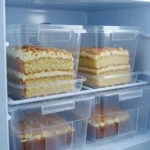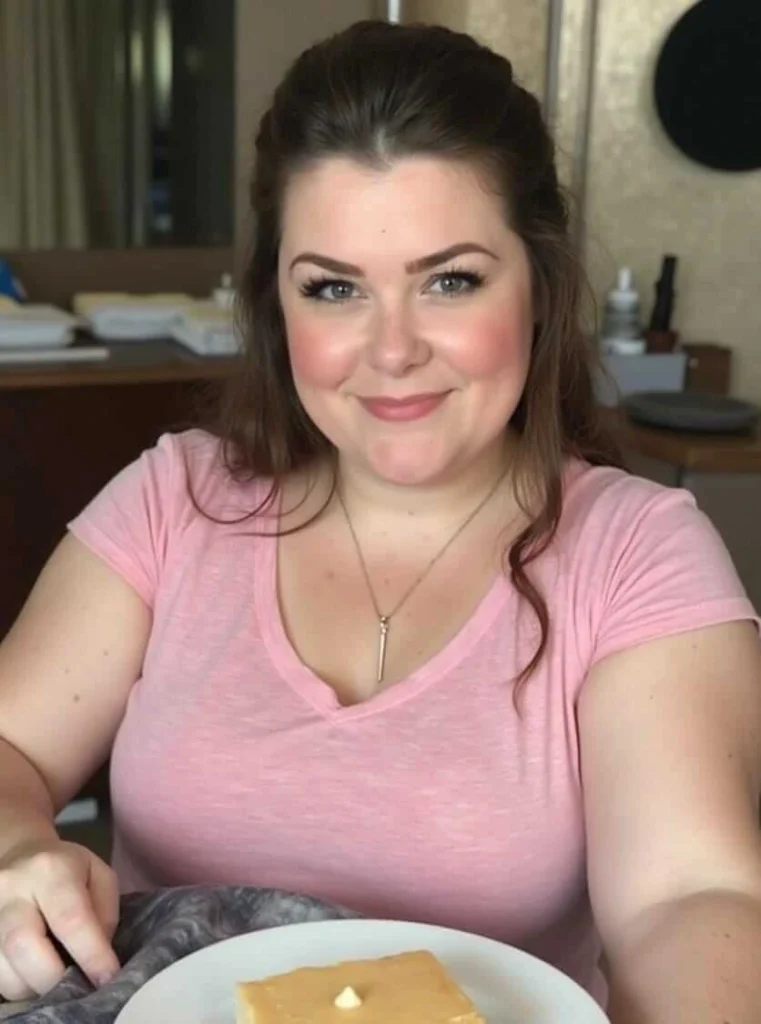The blue velvet cake recipe offers a vibrant and delightful variation of the traditional red velvet cake. With its striking blue hue and rich, moist texture, this cake is perfect for special occasions or simply to indulge in a unique dessert experience.
In this article, we’ll explore the origins of velvet cakes, delve into the specifics that make the blue velvet cake stand out, and provide a comprehensive guide to crafting this eye-catching treat.
Table of Contents
Table of Contents
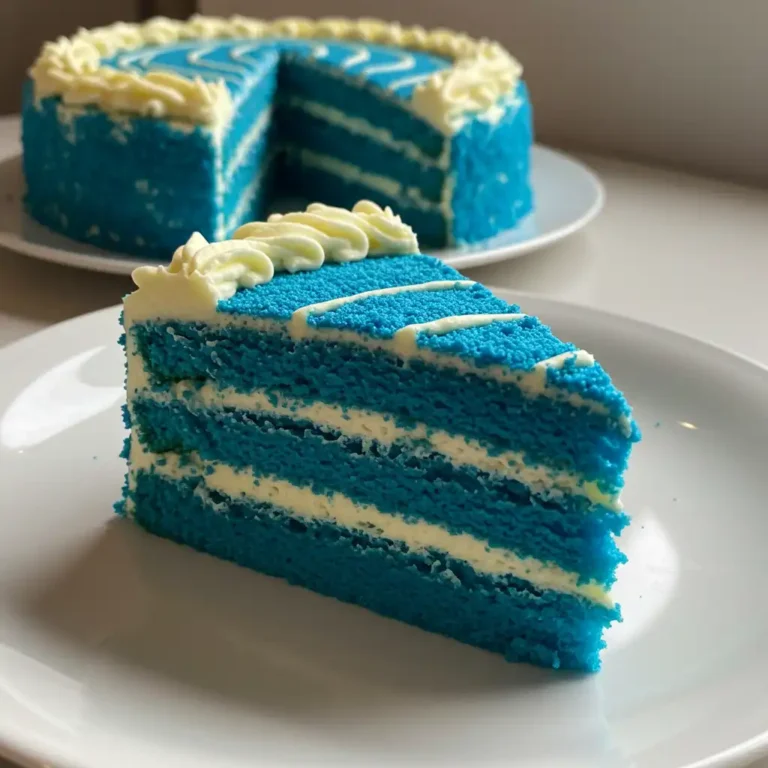
Blue Velvet Cake Recipe: A Colorful Twist on a Classic Dessert
Discover how to make a stunning blue velvet cake with a moist, tender crumb and subtle cocoa flavor. This colorful twist on the traditional velvet cake is perfect for celebrations or anytime you want to impress with a vibrant dessert.
- Total Time: 50 minutes
- Yield: 12 servings 1x
Ingredients
2 ½ cups all-purpose flour
1 ½ cups granulated sugar
1 teaspoon baking soda
1 teaspoon cocoa powder
½ teaspoon salt
1 cup buttermilk, room temperature
½ cup vegetable oil
2 large eggs, room temperature
1 tablespoon white vinegar
2 teaspoons vanilla extract
2 tablespoons blue food coloring (or natural blue alternatives)
For the Cream Cheese Frosting:
8 oz cream cheese, softened
½ cup unsalted butter, softened
4 cups powdered sugar
1 teaspoon vanilla extract
Instructions
Step 1: Preheat oven to 350°F (175°C). Grease and flour two 9-inch round cake pans.
Step 2: In a large bowl, sift together flour, sugar, baking soda, cocoa powder, and salt.
Step 3: In another bowl, whisk buttermilk, oil, eggs, vinegar, vanilla, and blue food coloring until well combined.
Step 4: Gradually add the wet ingredients to the dry, mixing until smooth and combined.
Step 5: Divide batter evenly into prepared pans and bake for 25-30 minutes or until a toothpick inserted in the center comes out clean.
Step 6: Remove cakes from oven, cool in pans for 10 minutes, then transfer to wire racks to cool completely.
Step 7: For frosting, beat cream cheese and butter until creamy. Add powdered sugar gradually and beat until fluffy. Mix in vanilla extract.
Step 8: Once cakes are fully cool, frost the layers evenly, stacking one on top of the other. Frost the outside of the cake as desired.
Notes
For a natural blue color, try using butterfly pea flower powder or spirulina powder instead of artificial dyes.
Make sure all wet ingredients are at room temperature to ensure proper mixing.
To prevent the cake from turning green, avoid overmixing the batter after adding food coloring.
- Prep Time: 20 minutes
- Cook Time: 30 minutes
- Category: Dessert
- Method: Baking
- Cuisine: American
Nutrition
- Serving Size: 1 slice (about 1/12th of the cake)
- Calories: 320
- Sugar: 28g
- Sodium: 200mg
- Fat: 18g
- Saturated Fat: 9g
- Unsaturated Fat: 7g
- Trans Fat: 0g
- Carbohydrates: 35g
- Fiber: 1g
- Protein: 4g
- Cholesterol: 55mg
Understanding the Blue Velvet Cake Phenomenon
The Origin of Velvet Cakes
Velvet cakes have a storied history, dating back to the 19th century. Originally, the term “velvet” referred to the cake’s soft and smooth texture, achieved by using specific ingredients like buttermilk and vinegar. The most renowned among them is the red velvet cake, known for its subtle cocoa flavor and distinctive red color.
Over time, bakers began experimenting with different colors, leading to the creation of various velvet cake versions, including blue velvet. This adaptation maintains the classic velvet texture while introducing a bold blue color, making it a visually stunning dessert choice.
What Makes Blue Velvet Cake Unique?
The blue velvet cake recipe distinguishes itself through its captivating color and the balance of flavors. While it shares the same foundational ingredients as its red counterpart such as buttermilk, vinegar, and a hint of cocoa the blue variant uses blue food coloring to achieve its signature hue.
This cake’s uniqueness lies not only in its appearance but also in its versatility. It’s a popular choice for themed events, from baby showers to patriotic celebrations, offering both aesthetic appeal and a delightful taste.
Essential Ingredients for the Perfect Blue Velvet Cake
Core Ingredients in a Traditional Blue Velvet Cake Recipe
To achieve the distinct texture and taste of a blue velvet cake recipe, it’s essential to use classic ingredients that contribute to the cake’s “velvety” crumb and subtle cocoa flavor. Here’s what you’ll need:
| Ingredient | Quantity | Purpose |
|---|---|---|
| All-purpose flour | 2½ cups | Base structure for the cake |
| Unsweetened cocoa powder | 1 tbsp | Gives a mild chocolate undertone |
| Baking soda | 1 tsp | Leavening agent for rise |
| Salt | ½ tsp | Balances sweetness and enhances flavor |
| Buttermilk | 1 cup | Creates moist texture and adds slight tang |
| White vinegar | 1 tsp | Reacts with baking soda for lift |
| Granulated sugar | 1½ cups | Sweetens and adds moisture |
| Unsalted butter | ½ cup (1 stick) | Adds richness and flavor |
| Eggs | 2 large | Binds ingredients and helps with structure |
| Vanilla extract | 2 tsp | Enhances overall flavor |
| Blue food coloring | 1–2 tbsp | Creates the iconic blue hue |
These ingredients are staples in any velvet cake recipe, but the blue velvet cake brings the drama with bold coloring and a delicate chocolate finish. You can substitute or tweak some of these based on dietary needs (we’ll cover that in Part 4).
Pro Tip: Always use room temperature ingredients for even mixing and better texture.
Choosing the Right Blue Food Coloring
One of the most frequently asked questions is: How to make cake mix blue? The answer lies in your food coloring choice. You have two primary options:
- Liquid food coloring – Easily available and affordable, but you may need more to get a vibrant blue.
- Gel food coloring – More concentrated, giving a richer color without altering the batter’s texture.
For natural alternatives, butterfly pea powder or spirulina can provide a natural blue hue. Just note that natural dyes may yield a more muted or greenish tint depending on the pH balance of your batter.
Tips for Avoiding a Green Tint in Blue Velvet Cake
If you’ve ever baked a blue velvet cake and ended up with a strange green color, you’re not alone. This often happens due to a chemical reaction between the cocoa powder and blue dye. Here’s how to avoid that:
- Use Dutch-processed cocoa which is less acidic.
- Avoid using baking powder with aluminum.
- Adjust pH with vinegar or buttermilk to balance acidity.
These adjustments help maintain that striking blue tone that makes this dessert stand out.
Step-by-Step Instructions for Baking Blue Velvet Cake
Preparing Your Equipment and Ingredients
Before you even preheat the oven, set yourself up for success by organizing everything you’ll need. This helps avoid missed steps or last-minute scrambles for ingredients.
- Preheat your oven to 350°F (175°C).
- Grease and flour two 9-inch round cake pans or line them with parchment paper.
- Set eggs, butter, and buttermilk on the counter to come to room temperature this ensures smoother mixing.
- Have all your ingredients measured and sifted where necessary.
Check out our guide on cake baking essentials for beginners if you’re new to baking or upgrading your kitchen tools.
Mixing the Blue Velvet Cake Batter
- Cream the butter and sugar
In a large mixing bowl, use an electric mixer to beat ½ cup of unsalted butter and 1½ cups of sugar until light and fluffy about 3–4 minutes. - Add the eggs one at a time
Crack in 2 large eggs, beating well after each one. This step helps incorporate air, giving your cake structure and softness. - Mix in the vanilla and food coloring
Stir in 2 tsp of vanilla extract and 1–2 tbsp of blue food coloring. Adjust for intensity. If using gel color, start small it’s potent. - Combine dry ingredients in a separate bowl
Whisk together 2½ cups of all-purpose flour, 1 tbsp of unsweetened cocoa powder, 1 tsp of baking soda, and ½ tsp of salt. - Alternate adding dry mix and buttermilk
Slowly add the dry ingredients to the wet batter, alternating with 1 cup of buttermilk, starting and ending with flour. Mix just until combined don’t overmix! - Add vinegar for lift
Stir in 1 tsp of white vinegar. This acidic component reacts with the baking soda to create that perfect velvet rise.
Pouring and Baking the Cake
- Divide the batter evenly into the prepared cake pans.
- Tap pans lightly on the counter to remove air bubbles.
- Bake for 28–32 minutes or until a toothpick inserted into the center comes out clean.
- Let the cakes cool in the pans for 10 minutes, then transfer to wire racks to cool completely.
Pro Tips for Perfect Texture and Color
- Avoid overbaking: It can dry out your velvet crumb.
- Use precise measurements: Baking is science. Use a digital scale for the most accurate results.
- Don’t skip the vinegar: It’s not just for color stability it adds tenderness to the cake.
Frosting Ideas and Flavor Pairings for Blue Velvet Cake
The Best Frostings for Blue Velvet Cake
When it comes to the blue velvet cake recipe, your choice of frosting plays a major role in the final flavor and aesthetic. The most traditional and beloved options include:
1. Cream Cheese Frosting
This classic frosting is the go-to for all velvet cakes and for good reason. It’s tangy, rich, and perfectly balances the subtle cocoa flavor of blue velvet cake.
Basic Cream Cheese Frosting Recipe:
| Ingredient | Amount |
|---|---|
| Cream cheese | 8 oz (1 block), softened |
| Unsalted butter | ½ cup (1 stick), softened |
| Powdered sugar | 3–4 cups, sifted |
| Vanilla extract | 2 tsp |
Instructions:
- Beat the cream cheese and butter together until smooth.
- Gradually add powdered sugar while mixing on low.
- Stir in the vanilla extract and beat until fluffy.
2. Whipped Vanilla Buttercream
A fluffier alternative with a lighter taste and sweet vanilla finish. It’s great for piping and decorating if you want an elegant presentation.
3. Mascarpone Frosting
This European-style frosting offers a smooth, slightly tangy bite and pairs especially well with fruit fillings.
4. White Chocolate Ganache
For a decadent twist, pour a layer of white chocolate ganache between cake layers or as a glaze over the top. It adds a sweet and luxurious finish.
Flavor Pairings That Complement Blue Velvet Cake
To elevate your blue velvet cake recipe, consider these flavor combinations that enhance the cake’s mildly chocolatey, rich base:
| Complementary Flavor | Why It Works |
|---|---|
| Fresh berries (blueberries, raspberries) | Add natural sweetness and vibrant contrast |
| Lemon or orange zest | Brings a bright citrus pop to balance richness |
| Toasted coconut | Adds texture and a nutty undertone |
| Dark chocolate shavings | Enhances the cocoa notes subtly present |
| Salted caramel drizzle | Contrasts the sweetness and adds complexity |
How to Color Match Frosting and Cake for Aesthetic Impact
A lot of bakers want to know: How do I match the frosting to the cake for visual impact? Here’s the trick:
- White or ivory frosting makes the blue pop perfect for contrast.
- Ombre blue tones in buttercream give a modern, gradient look.
- Edible pearls or gold leaf add elegance without overpowering the hue.
If you’re using natural blue food colorings, your frosting choices should avoid acidic reactions that could shift the blue tone to green or purple. Keep it neutral and dairy-based for best results.
Healthy Swaps and Dietary Alternatives for Blue Velvet Cake
How to Make a Healthier Blue Velvet Cake Recipe
If you’re looking to lighten things up without sacrificing flavor or texture, you can modify your blue velvet cake recipe with a few smart ingredient swaps.
1. Whole Wheat or Oat Flour
Replace up to 50% of all-purpose flour with whole wheat flour or oat flour for extra fiber and nutrients. This also adds a slightly nutty flavor that pairs well with blue velvet.
| Original Ingredient | Healthier Swap |
|---|---|
| All-purpose flour | 50% whole wheat flour |
| Granulated sugar | Coconut or maple sugar |
| Vegetable oil | Unsweetened applesauce |
| Buttermilk | Low-fat Greek yogurt |
2. Natural Sweeteners
Skip refined sugars and use options like:
- Honey (use ¾ cup for every 1 cup sugar)
- Coconut sugar (1:1 ratio)
- Date paste (great in frostings or fillings)
Vegan Blue Velvet Cake Alternatives
Need a plant-based blue velvet cake recipe? No problem. With these simple swaps, your cake will still be soft, moist, and just as show-stopping.
- Egg replacement: Use 1 tablespoon ground flaxseed + 3 tablespoons water = 1 egg
- Buttermilk substitute: Mix 1 cup soy or almond milk + 1 tbsp apple cider vinegar
- Butter substitute: Vegan margarine or solid coconut oil
- Cream cheese frosting: Use vegan cream cheese and plant-based butter
Pro Tip:
Look for natural plant-based blue food coloring made from spirulina or red cabbage to keep your cake vegan and dye-free.
Don’t miss our guide on vegan velvet cake tips for plant-based perfection every time.
Gluten-Free Blue Velvet Cake Options
For those sensitive to gluten, this version is a game-changer. Here’s how to get that iconic velvet texture without the gluten:
- Use a gluten-free all-purpose flour blend that includes xanthan gum.
- Add an extra egg or 2 tablespoons of yogurt to keep the cake moist.
- Don’t skip the vinegar buttermilk reaction, which is key to the cake’s softness.
Low-Sugar and Diabetic-Friendly Variations
To reduce the sugar load without compromising flavor:
- Use stevia or erythritol in a 1:1 ratio.
- Pair the cake with a light yogurt-based or cream cheese frosting using monk fruit sweetener.
- Add flavor with natural extracts like almond or coconut to distract from reduced sweetness.
Allergy-Friendly Modifications
If you’re baking for someone with allergies, consider the following:
| Allergy | Swap Idea |
|---|---|
| Dairy | Almond, oat, or soy milk, vegan butter |
| Eggs | Mashed banana, flax egg, or aquafaba |
| Gluten | GF flour blend with xanthan gum |
| Nuts | Avoid nut-based flours or frostings |
Table: Summary of Dietary Swaps
| Dietary Need | Swap Recommendations |
|---|---|
| Vegan | Flax eggs, plant milk, vegan cream cheese |
| Gluten-Free | GF flour mix, extra moisture agents |
| Low Sugar | Erythritol, monk fruit, natural extracts |
| Nut-Free | Avoid almond flour or nut-based toppings |
Decorating Tips and Presentation Ideas for Blue Velvet Cake
Elevate Your Blue Velvet Cake with Stunning Presentation
A well-decorated blue velvet cake recipe turns heads and steals the show at any celebration. Whether you’re baking for a birthday, wedding, or simply to impress your guests, your blue velvet cake can be as bold or elegant as you like. Let’s explore how to get it right.
Choosing the Right Frosting for Blue Velvet Cake
The contrast between the vivid blue cake and creamy frosting is key to visual appeal. Popular choices include:
1. Cream Cheese Frosting
A classic choice for velvet cakes. Its tangy flavor balances the rich sweetness of the cake perfectly.
- For extra smoothness, beat the frosting for 3–4 minutes.
- Add a splash of vanilla or almond extract for a deeper flavor profile.
2. Buttercream Frosting
If you prefer a sweeter and more stable frosting (especially for piping), go for classic American or Swiss meringue buttercream.
- Tint it with a pale blue or white to match your theme.
- Add edible glitter or gold dust for a luxe finish.
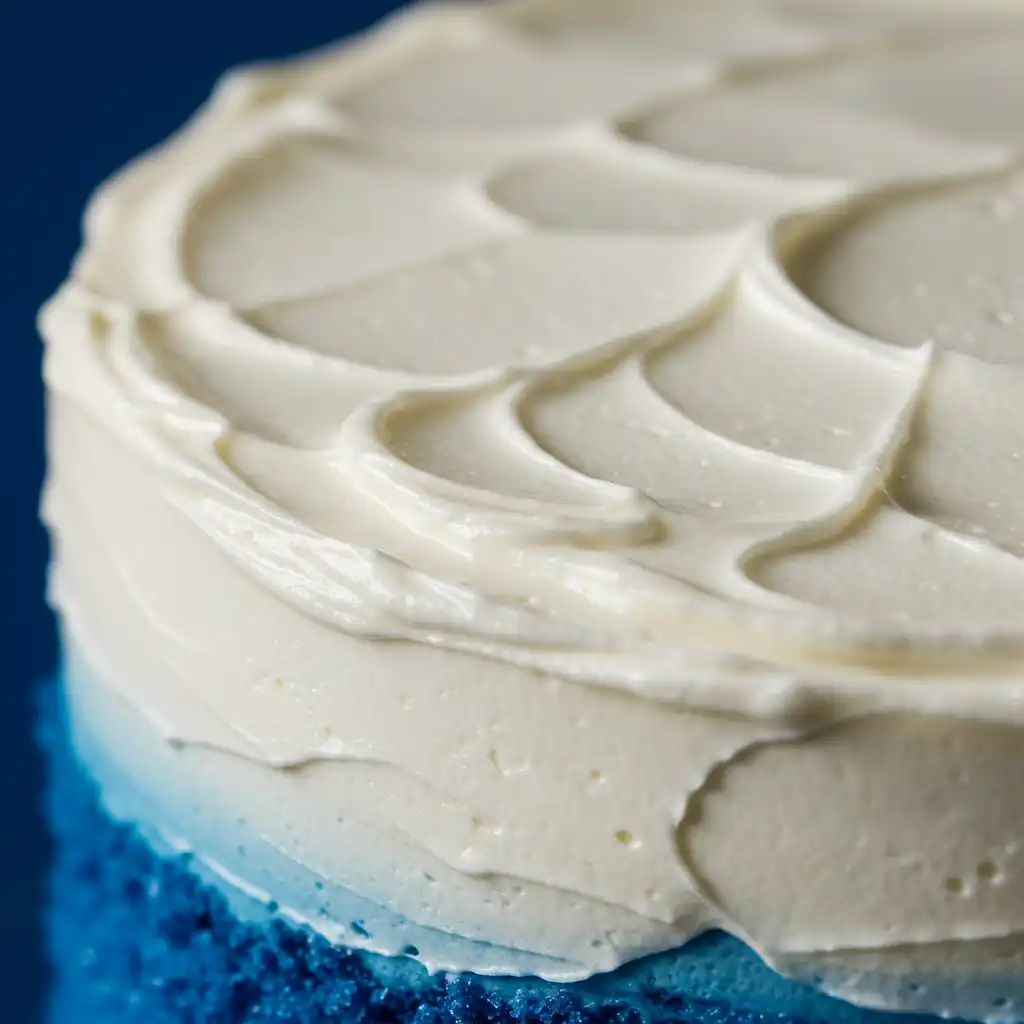
Color Pairing and Cake Aesthetics
When styling your blue velvet cake, complementary colors make a big impact.
| Color Theme | Elements to Include |
|---|---|
| Blue + White | White frosting, blueberries, edible pearls |
| Blue + Silver | Silver leaf, metallic cake toppers |
| Blue + Gold | Gold sprinkles, ribbon borders |
| Blue Ombre | Gradual frosting tint from dark to light blue |
Use a rotating cake stand to frost and decorate evenly. This helps achieve a smooth and polished look.
Decorating with Fruits, Flowers, and Garnishes
Adding garnishes enhances flavor and visual appeal. Try:
- Fresh blueberries for a pop of color and tartness
- Edible flowers like violets or pansies for a romantic look
- White chocolate curls for elegance
- Gold leaf or metallic sprinkles for special events
Piping Techniques to Impress
Use different piping tips to create textures and designs that elevate your cake.
- Rosettes and ruffles for a romantic finish
- Shell borders for clean edges
- Star tips for fluffy swirls on top
Layer and Tier Decoration Ideas
For multi-layer or tiered blue velvet cakes, keep these tricks in mind:
- Alternate cake layers with different blue intensities for an ombre effect.
- Use cake dowels for support when stacking multiple tiers.
- Decorate each tier uniquely to add depth and contrast.
Themed Decoration Ideas
Get creative with themes for birthdays, holidays, or special occasions:
| Occasion | Decoration Ideas |
|---|---|
| Baby Shower | Blue fondant booties, white baby blocks |
| Wedding | Silver beads, lace piping, personalized toppers |
| Fourth of July | Red and white accents with a blue velvet base |
| Winter Party | Snowflake sprinkles, icy blue frosting swirls |
Don’t miss our holiday-themed cake ideas to inspire your next event centerpiece.
How to Photograph Your Blue Velvet Cake
Presentation doesn’t stop at the table photos matter too, especially if you’re sharing your masterpiece online.
Tips for Better Cake Photos:
- Use natural lighting near a window.
- Use a clean white or neutral background.
- Capture close-ups of the texture and slices.
- Include props like flowers, utensils, or a fork with cake bite for lifestyle effect.
Common Mistakes and Troubleshooting Tips for Blue Velvet Cake Recipe
Avoid These Common Blue Velvet Cake Baking Mistakes
Baking a blue velvet cake recipe might seem straightforward, but a few slip-ups can turn your stunning cake into a baking blunder. Here are the most frequent mistakes and how to avoid them.
1. Using the Wrong Type of Blue Food Coloring
Not all blue food colorings are created equal. Some artificial dyes can turn your blue velvet cake green or gray after baking.
- Opt for gel-based or natural blue coloring made from spirulina or butterfly pea flower for vibrant, stable hues.
- Avoid liquid food dyes that may dilute your batter and affect texture.
2. Overmixing the Batter
Overmixing develops gluten and results in a dense, tough cake rather than the soft velvet texture you want.
- Mix ingredients just until combined.
- Use gentle folding motions once dry ingredients are added.
3. Skipping the Buttermilk or Vinegar
The acidity from buttermilk and vinegar is key to the blue velvet cake’s tender crumb and subtle tang.
- Substitute with low-fat yogurt or a milk + lemon juice mix if needed.
- Don’t skip these ingredients they also enhance the color’s vibrancy.
4. Incorrect Oven Temperature or Baking Time
Baking at too high a temperature can brown the edges while leaving the center undercooked.
- Preheat your oven fully and bake at 325-350°F.
- Use an oven thermometer to ensure accuracy.
- Test doneness with a toothpick inserted into the center.
5. Using Expired Leavening Agents
Old baking powder or baking soda can prevent your cake from rising properly.
- Check expiry dates and store leavening agents in a cool, dry place.
- Test baking powder by adding a teaspoon to hot water; it should bubble vigorously.
Troubleshooting Common Blue Velvet Cake Problems
| Problem | Cause | Solution |
|---|---|---|
| Cake is dense or heavy | Overmixing or too much flour | Mix gently; measure flour properly |
| Cake is dry | Overbaking or insufficient fat | Check oven temp; add oil or applesauce swap |
| Cake color faded or dull | Poor quality food coloring | Use gel or natural food coloring |
| Cake sinks in the middle | Too much leavening or underbaking | Measure baking soda accurately; test doneness |
| Frosting is runny | Warm cake or overbeating frosting | Chill cake; whip frosting to stiff peaks |
Tips for Perfect Blue Velvet Cake Every Time
- Measure ingredients carefully using a kitchen scale.
- Room temperature ingredients mix better and improve texture.
- Sift flour and cocoa powder to avoid lumps.
- Use an egg substitute if vegan or allergy-friendly options are needed.
- Always cool cakes completely before frosting to prevent melting.
Discover more tips in our full guide on troubleshooting common cake baking issues.
Storage, Shelf Life, and Reheating Tips for Blue Velvet Cake Recipe
How to Store Your Blue Velvet Cake to Keep It Fresh
Proper storage is essential to maintain the moist texture and vibrant color of your blue velvet cake recipe. Here’s how to store it right:
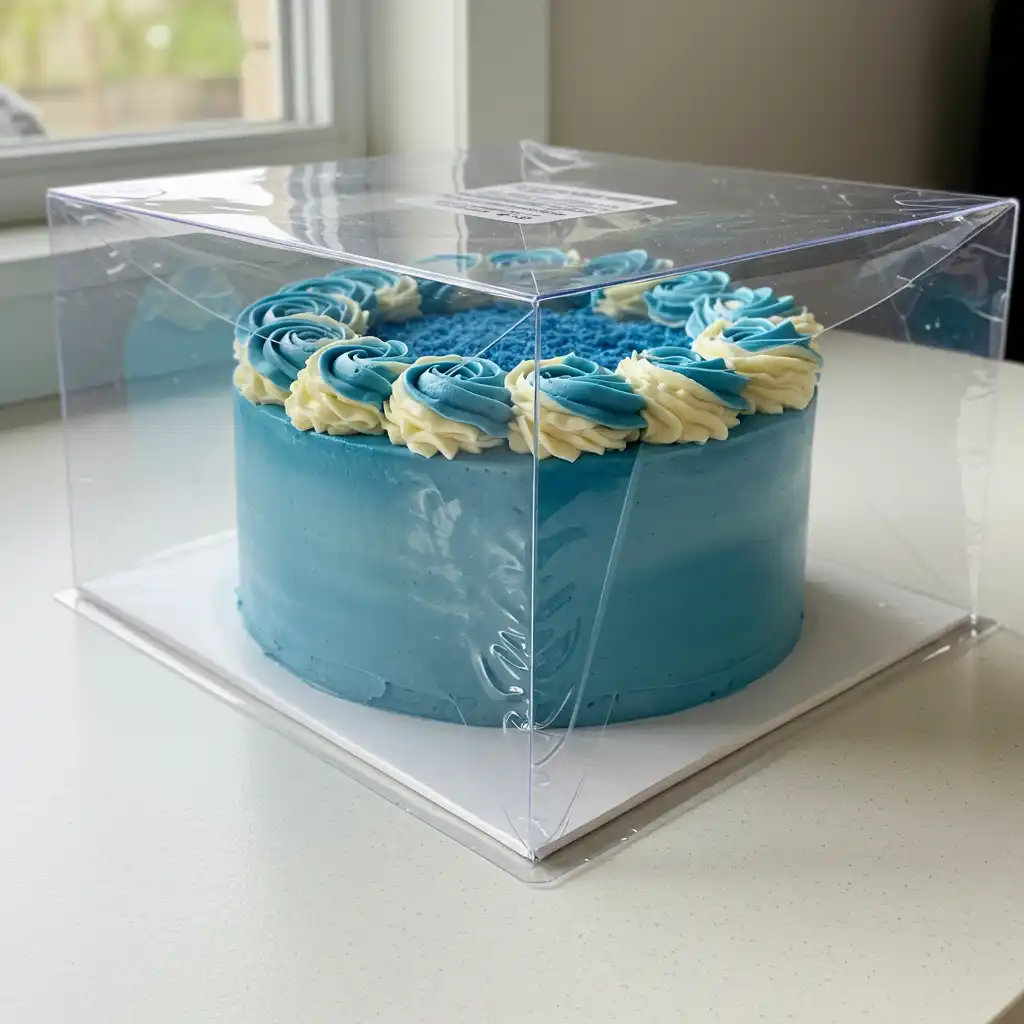
Storing at Room Temperature
- Wrap the cake tightly in plastic wrap or store in an airtight container.
- Keep it in a cool, dry place away from direct sunlight.
- Best consumed within 1-2 days at room temperature for optimum freshness.
Refrigeration Tips
- If you need to store your cake longer, refrigerate it to extend shelf life up to 5-7 days.
- Before refrigerating, cover the cake with plastic wrap or place in an airtight container to prevent drying.
- Note: Refrigeration can slightly dull the cake’s vibrant blue color and make the frosting firmer.
Freezing Your Blue Velvet Cake
Freezing is a great way to preserve your cake if you want to enjoy it later.
- Wrap the cake layers tightly in plastic wrap and then aluminum foil.
- Place wrapped layers in a freezer-safe container or zip-top bag.
- Freeze for up to 3 months without significant loss of flavor or texture.
- Thaw frozen cake layers overnight in the refrigerator before frosting and serving.
Reheating Blue Velvet Cake
Blue velvet cake tastes best fresh but can be gently reheated if desired:
- Microwave individual slices for 10-15 seconds on low power to warm slightly.
- Avoid overheating, which can dry out the cake.
- For a more even reheat, wrap slices in foil and warm in a 300°F oven for 10 minutes.
Tips to Keep Frosting Fresh
- Store frosted cake in the fridge if the frosting contains cream cheese or dairy.
- Allow refrigerated cake to sit at room temperature for 30 minutes before serving for the best texture.
- Avoid freezing frosted cakes as frosting texture can be affected.
Signs Your Blue Velvet Cake Has Gone Bad
- Off smell or sour taste.
- Visible mold or discoloration.
- Frosting that has separated or looks watery.
Always trust your senses and when in doubt, discard the cake to avoid any health risks.
Looking for inspiration? Try our tips on cake storage hacks for keeping desserts fresh longer.
Conclusion and Frequently Asked Questions About Blue Velvet Cake Recipe
Conclusion: Why You Should Try This Blue Velvet Cake Recipe Today
The blue velvet cake recipe is a unique and delightful twist on the classic velvet cake, offering stunning color and a moist, tender crumb with a subtle tang from buttermilk and vinegar. Whether you’re baking for a special occasion or simply craving something new and eye-catching, this recipe guarantees a delicious result that will impress family and friends alike.
From selecting the right blue food coloring to avoiding common baking mistakes, this guide has covered all you need to master the art of blue velvet cake baking. Proper storage and reheating tips ensure your cake stays fresh and delicious long after baking. So why wait? Give this recipe a try and bring a vibrant splash of color and flavor to your dessert table.
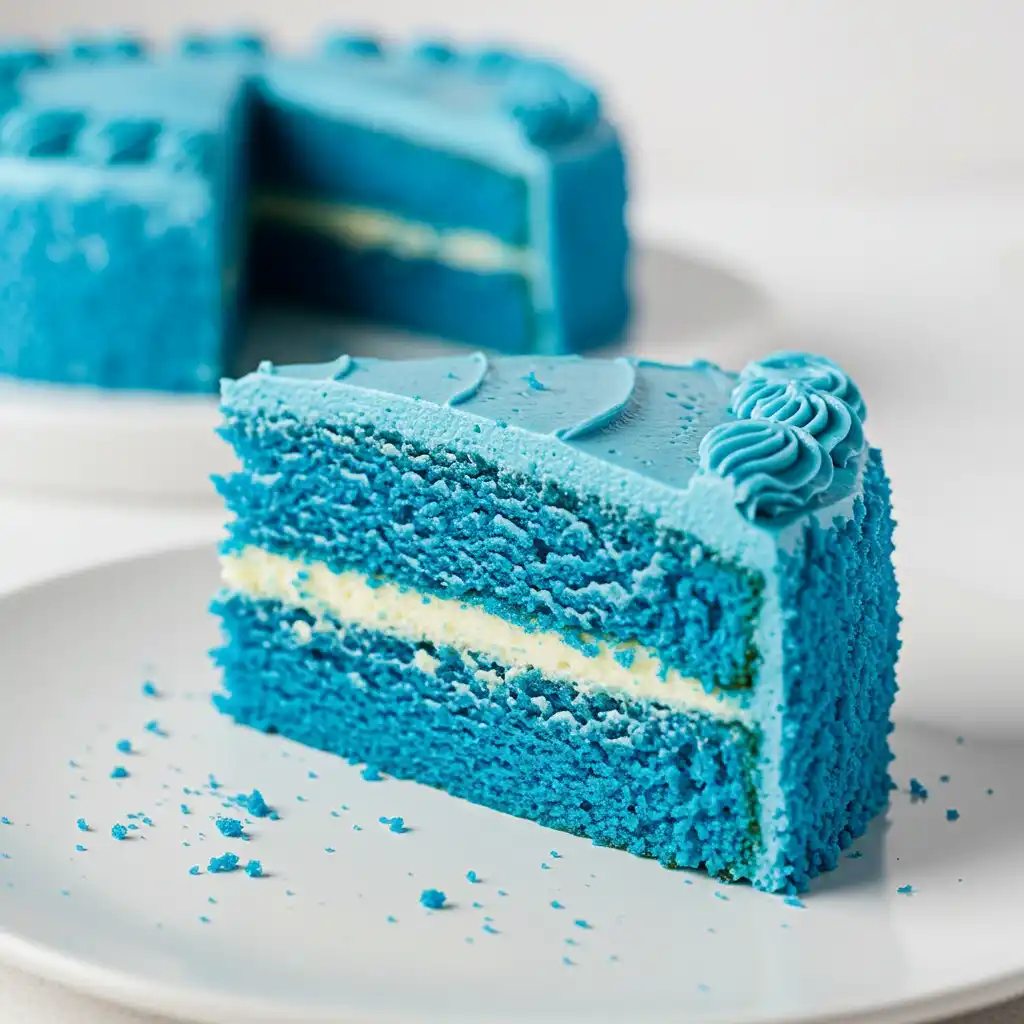
“Discover more tasty recipes by following me on Facebook, Pinterest, and Medium.”
Frequently Asked Questions About Blue Velvet Cake Recipe
Does purple velvet cake exist?
Yes, purple velvet cake is a variation that uses purple food coloring or natural sources like ube or purple yam to create a similar texture with a different hue.
What is pink velvet cake?
Pink velvet cake is a softer variation of red velvet cake that uses pink food coloring instead of red, resulting in a lighter, sweeter flavor and a gentle pink color.
What is the difference between red and blue velvet?
While both share a tender crumb and mild cocoa flavor, blue velvet cake uses blue coloring and sometimes slightly different flavor notes, such as vanilla and citrus, to complement the unique color.
How to make cake mix blue?
Add gel or natural blue food coloring in small amounts to the batter, mixing gently until you reach your desired shade of blue.
Is velvet cake just chocolate cake but red?
No, velvet cake differs from traditional chocolate cake by using buttermilk and vinegar, which create a moist texture and tangy flavor, along with subtle cocoa powder, rather than intense chocolate.
Why is my blue velvet cake green?
This is often due to a chemical reaction between acidic ingredients (like buttermilk) and certain blue dyes. Using stable gel or natural blue coloring can prevent this.
What is a black velvet cake?
Black velvet cake is a dark chocolate cake variant, often made with extra cocoa powder or black food coloring, resulting in a deep, rich color and flavor.
What is the flavor of pink velvet?
Pink velvet cake typically has a mild cocoa flavor with a sweet, creamy vanilla undertone.
Does blue velvet cake exist?
Yes, blue velvet cake exists and is a creative spin on traditional velvet cakes, using blue coloring to create a visually stunning dessert.
What is the natural blue color for cake?
Natural blue coloring can be derived from ingredients like butterfly pea flower or spirulina, which provide vibrant blue hues without artificial dyes.
What does white velvet cake taste like?
White velvet cake has a subtle vanilla flavor with the same tender crumb and mild tang from buttermilk and vinegar, but without cocoa powder.
How to make blue color for cake?
Use gel or powdered blue food coloring, or natural sources like butterfly pea flower powder, mixed into the batter for consistent blue coloring.
How to make food blue without dye?
Natural options include butterfly pea flower, spirulina powder, or red cabbage juice (though cabbage may lean more purple), which can be used to color food blue naturally.
What two colors make blue?
In pigment mixing, blue is a primary color and cannot be made by mixing other colors. In light (additive color), blue can be made by mixing cyan and magenta light.
Did You Try Our Recipe?
There are no reviews yet. Be the first one to write one.




